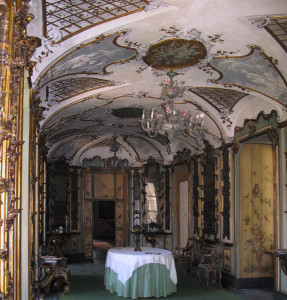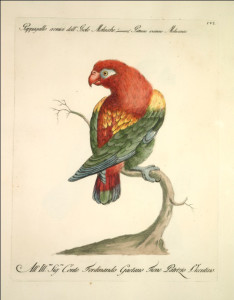Flight of Fancy: The Galleria degli Uccelli in the Palazzo Biscari, Catania
By Kathleen M. Bennett
Independent Scholar
The arrival of design sources promoting the new rococo style in Sicily in the mid-1700s heralded a new chapter in the island’s architectural vocabulary, which was previously grounded in baroque taste. Architects and patrons embraced these novel designs, which added drama, flair, and spontaneity to interiors of impressive palazzi, as exemplified by Palazzo Biscari in Catania, a site included in the Trust’s recent tour of Sicily.
Following a devastating earthquake in 1693, the municipal, ecclesiastical, and aristocratic patrons of Catania initiated an extensive rebuilding campaign. The Paternò-Castello family was granted the privilege of building their palazzo on the ancient walls of the city. Palazzo Biscari was constructed in stages by consecutive princes. Ignazio Paternò-Castello V (1719–1786) embraced the rococo for the decoration of his private spaces within the palazzo.
Situated in the heart of the complex, Paternò-Castello’s Galleria degli Uccelli was designed as a long hallway, punctuated by French doors opening onto balconies overlooking two interior courtyards. The galleria is one of a number of small rooms within the palazzo that invoke a sense of enclosure and intimacy, ideal for small-scale entertaining, which had recently come into vogue. The walls and doors of the galleria are adorned with a profusion of naturalistic motifs, including a splendid variety of cavorting and posturing birds, set within a framework of chinoiserie, cartouches, and lattice- work.
My research on the palazzo led to the discovery of the ornithological design source, La Storia Naturale degli Uccelli, a five-volume treatise published in Florence between 1767 and 1776. The birds, meticulously rendered by an anonymous artist in the galleria, are mainly from Volume 1 (1767). Each example, and there are over three hundred varieties, has a flowing, asymmetrical ribbon attached, with its name and country of origin specified. Although the date of La Storia Naturale’s arrival in Catania is unknown, as is the identity of the volume’s owner, the timing leads one to speculate that it appeared in Catania during the palazzo’s redecoration in anticipation of Ignazio’s son’s wedding in 1775.
Visitors to Palazzo Biscari marveled at the room. They were not only impressed by the variety of painted bird images, some never seen on Sicilian soil, but also by dozens of Bow porcelain birds displayed on small shelves incorporated into the carved woodwork throughout the hall. We can imagine the magical interior at night, with the shutters closed, candlelight reflected in mirrors, and the painted and soft-paste porcelain birds on display.
Paternò-Castello’s ornithological gallery survives as an important Sicilian interpretation of the rococo style, which proved influential in Catania. Images of birds from these volumes later appear in other venues in Catania, such as an uccelliera or music-box at the Chiesa di San Nicola L’Arena (ca. 1785) and the grand ballroom of the Palazzo Zappalà-Gemilli (ca. 1800).
SAVE THE DATE
- Special Symposium
“Classical Splendor”
The Philadelphia Museum of Art
November 4, 2016 - New York Antiques Weekend
January 20-21, 2017 - Spring Symposium
Savannah
April 21-24, 2017 - Spring Study Trip Abroad
Scotland
May 14-22, 2017 - Fall Symposium
Hartford & Western Connecticut
September 2017 - Fall Study Trip Abroad
Venice and the Veneto
October 9-16 and 22-29, 2017
By Kathleen M. Bennett
Independent Scholar
The arrival of design sources promoting the new rococo style in Sicily in the mid-1700s heralded a new chapter in the island’s architectural vocabulary, which was previously grounded in baroque taste. Architects and patrons embraced these novel designs, which added drama, flair, and spontaneity to interiors of impressive palazzi, as exemplified by Palazzo Biscari in Catania, a site included in the Trust’s recent tour of Sicily.
Following a devastating earthquake in 1693, the municipal, ecclesiastical, and aristocratic patrons of Catania initiated an extensive rebuilding campaign. The Paternò-Castello family was granted the privilege of building their palazzo on the ancient walls of the city. Palazzo Biscari was constructed in stages by consecutive princes. Ignazio Paternò-Castello V (1719–1786) embraced the rococo for the decoration of his private spaces within the palazzo.
Situated in the heart of the complex, Paternò-Castello’s Galleria degli Uccelli was designed as a long hallway, punctuated by French doors opening onto balconies overlooking two interior courtyards. The galleria is one of a number of small rooms within the palazzo that invoke a sense of enclosure and intimacy, ideal for small-scale entertaining, which had recently come into vogue. The walls and doors of the galleria are adorned with a profusion of naturalistic motifs, including a splendid variety of cavorting and posturing birds, set within a framework of chinoiserie, cartouches, and lattice- work.
My research on the palazzo led to the discovery of the ornithological design source, La Storia Naturale degli Uccelli, a five-volume treatise published in Florence between 1767 and 1776. The birds, meticulously rendered by an anonymous artist in the galleria, are mainly from Volume 1 (1767). Each example, and there are over three hundred varieties, has a flowing, asymmetrical ribbon attached, with its name and country of origin specified. Although the date of La Storia Naturale’s arrival in Catania is unknown, as is the identity of the volume’s owner, the timing leads one to speculate that it appeared in Catania during the palazzo’s redecoration in anticipation of Ignazio’s son’s wedding in 1775.
Visitors to Palazzo Biscari marveled at the room. They were not only impressed by the variety of painted bird images, some never seen on Sicilian soil, but also by dozens of Bow porcelain birds displayed on small shelves incorporated into the carved woodwork throughout the hall. We can imagine the magical interior at night, with the shutters closed, candlelight reflected in mirrors, and the painted and soft-paste porcelain birds on display.
Paternò-Castello’s ornithological gallery survives as an important Sicilian interpretation of the rococo style, which proved influential in Catania. Images of birds from these volumes later appear in other venues in Catania, such as an uccelliera or music-box at the Chiesa di San Nicola L’Arena (ca. 1785) and the grand ballroom of the Palazzo Zappalà-Gemilli (ca. 1800).



